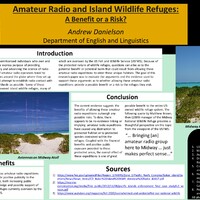Amateur Radio and Island Wildlife Refuges: A Benefit or a Risk?
Item
Poster Number
4
Poster Title
Amateur Radio and Island Wildlife Refuges: A Benefit or a Risk?
First Presenter
Andrew Danielson
Abstract
My research paper evaluates evidence as to whether allowing amateur radio expeditions into US-owned island wildlife refuges is a potential benefit or a potential risk to these wildlife refuges. This paper is important because it evaluates the current evidence as to optimal interaction conditions between humans and protected island wildlife habitats. These expeditions usually consist of 10-20 individuals who travel to remote locations, such as wildlife refuges, for the express purpose of setting up temporary, low-impact radio stations to attempt to contact as many radio amateurs worldwide as possible during a period of one to two weeks, before returning home. Many of these island wildlife refuges are in very remote parts of the world, such as Baker Island located in the Pacific Ocean. These refuges, overseen primarily by the US Fish and Wildlife Service, do contain fragile and rare habitats and species. Thusly, whenever such expeditions are proposed to these refuges, questions are raised as to whether allowing such an activity will unduly jeopardize the health and vitality of the refuge. The results of my research were intriguing, with sources including the US Fish and Wildlife Service, non-profit conservation organizations like the Marine Conservation Institute and Audubon Society, and personal interviews with recognized experts in the biological and amateur radio worlds. In brief summary, there are two major concerns raised over allowing these expeditions into these protected wildlife sanctuaries. First, such expeditions could potentially increase the risk of foreign, biological material entering and possibly damaging the refuge’s environment. Secondly, the US Fish and Wildlife Service is concerned that allowing these expeditions would potentially increase the financial burden on the Fish and Wildlife Service, since the US Fish and Wildlife Service must send along either a staff member or a “Service approved” biologist to oversee the expedition’s footprint in the refuge. However, there are two potential benefits in allowing these expeditions. Such amateur radio expeditions give the scientific community, especially the US Fish and Wildlife Service, an opportunity to visit these remote island sanctuaries at a greatly reduced total cost to the Service. These visits enable scientists to conduct research and wildlife officials to carry out necessary management work for the refuge. Secondly, the amateur radio expeditions provide the US Fish and Wildlife Service with additional opportunities to educate and inform the public as to the existence and purpose of these protected areas. The positive public exposure provided by these expeditions can potentially increase public support for these US-owned wildlife sanctuaries. Therefore, based on the evidence from the research I was able to conduct on this topic, the evidence seems to indicate that allowing amateur radio expeditions into these wildlife refuges is a greater possible benefit than a possible risk.
Year
2022
Embargo
no embargo
